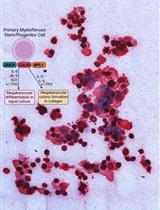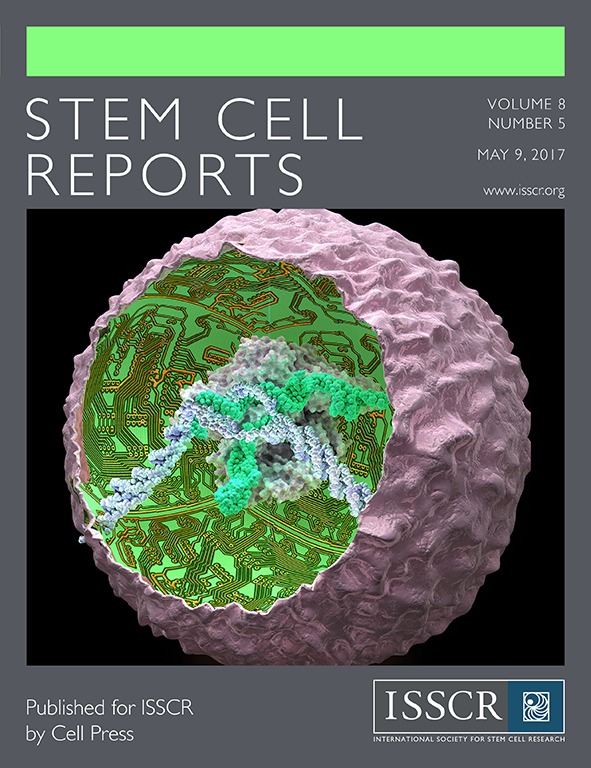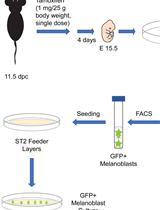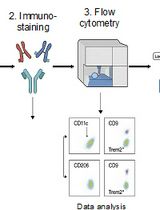- EN - English
- CN - 中文
FACS-based Isolation of Neural and Glioma Stem Cell Populations from Fresh Human Tissues Utilizing EGF Ligand
基于FACS利用EGF配体从新鲜人组织中分离神经和胶质瘤干细胞群
发布: 2017年12月20日第7卷第24期 DOI: 10.21769/BioProtoc.2659 浏览次数: 13819
评审: Liang-Chun WANGMahesh AppariAnonymous reviewer(s)

相关实验方案

来自骨髓增生性肿瘤患者的造血祖细胞的血小板生成素不依赖性巨核细胞分化
Chloe A. L. Thompson-Peach [...] Daniel Thomas
2023年01月20日 2302 阅读
Abstract
Direct isolation of human neural and glioma stem cells from fresh tissues permits their biological study without prior culture and may capture novel aspects of their molecular phenotype in their native state. Recently, we demonstrated the ability to prospectively isolate stem cell populations from fresh human germinal matrix and glioblastoma samples, exploiting the ability of cells to bind the Epidermal Growth Factor (EGF) ligand in fluorescence-activated cell sorting (FACS). We demonstrated that FACS-isolated EGF-bound neural and glioblastoma populations encompass the sphere-forming colonies in vitro, and are capable of both self-renewal and multilineage differentiation. Here we describe in detail the purification methodology of EGF-bound (i.e., EGFR+) human neural and glioma cells with stem cell properties from fresh postmortem and surgical tissues. The ability to prospectively isolate stem cell populations using native ligand-binding ability opens new doors for understanding both normal and tumor cell biology in uncultured conditions, and is applicable for various downstream molecular sequencing studies at both population and single-cell resolution.
Keywords: EGF (EGF)Background
Understanding the intrinsic biology of human neural and glioma stem cells has been challenging, due to the lack of universal neural and glioma stem cell markers (Lathia et al., 2015) and the frequent reliance on cultured cells rather than those isolated directly from the tissue. The transmembrane glycoprotein Prominin, or CD133, is one of the best described and frequently used stem cell markers for the isolation of neural (Uchida et al., 2000) and glioma stem cells (GSC) (Singh et al., 2003; Singh et al., 2004; Lathia et al., 2015), with its utility being demonstrated in both acutely sorted human tissues and neurospheres. However, some recent studies have pointed out that CD133-negative cells isolated from human glioblastoma (GBM) also harbor stem cell properties (Beier et al., 2007; Wang et al., 2008; Tome-Garcia et al., 2017). Other cell surface markers used to isolate GSC include CD44 (Anido et al., 2010), CD15 (Son et al., 2009), A2B5 (Ogden et al., 2008), integrin alpha (Lathia et al., 2010) or EGFR (Mazzoleni et al., 2010), but these antibody-based methodologies have also lacked the ability to capture all sphere-forming populations or their use has been limited to cultured cells.
A direct comparison of the molecular phenotypes between non-neoplastic and tumoral stem cell niches can provide novel insight into the developmental pathways co-opted during tumor formation and may uncover more comprehensive stem cell markers. In the context of gliomagenesis, several developmental pathways important for the growth and proliferation of normal neural progenitors have been demonstrated to be aberrantly reactivated during gliomagenesis (Sanai et al., 2005; Canoll and Goldman, 2008; Chen et al., 2012; Tsankova and Canoll, 2014; Lathia et al., 2015). Among these is the Epidermal Growth Factor Receptor (EGFR) tyrosine kinase pathway. Expression of EGFR is high during human neural development, especially within the germinal matrix stem cell niche, diminishing significantly in adulthood (Weickert et al., 2000; Sanai et al., 2011; Erfani et al., 2015), and it is aberrantly re-activated in GBM (Verhaak et al., 2010; Brennan et al., 2013). Recently, we adapted a mouse fluorescence-activated cell sorting (FACS) strategy, which selects for EGFR+ cells based on their native binding to EGF ligand (Ciccolini et al., 2005; Pastrana et al., 2009; Codega et al., 2014), and isolated human EGFR+ populations from fresh germinal matrix (GM) dissections and GBM tissues. This allowed us to directly compare the functional properties and whole-transcriptome signatures in developing and neoplastic neural populations (Tome-Garcia et al., 2017). EGFR+ populations from both GM and GBM tissues captured all sphere-forming cells in vitro, displayed similar proliferative stem cell properties, and shared transcriptome signatures related to cell growth and cell-cycle regulation. EGFR+ GBM populations also displayed tumor initiation in vivo (Tome-Garcia et al., 2017). Below, we describe this prospective purification strategy for neural and glioblastoma populations with stem cell properties from primary human samples, detailing the steps of tissue dissociation, ligand/antibody incubation, FACS, and in vitro functional stem cell property analysis.
Materials and Reagents
- Pipette tips (Fisher Scientific, FisherbrandTM, catalog numbers: 02-707-404 ; 02-707-430 ; 02-707-432 )
- American Safety Razors PersonnaTM PalTM Single Edge Blade (AccuTec Blades, catalog number: 620177 )
- Falcon tissue culture dish (Corning, Falcon®, catalog number: 353002 )
- Falcon® 15 ml conical centrifuge tubes (Corning, Falcon®, catalog number: 352099 )
- 40 μm cell strainer (Corning, Falcon®, catalog number: 352340 )
- 1.7 ml Microcentrifuge snap-cap tubes (Corning, Costar®, catalog number: 3621 )
- Ultra Low attachment 96-well plates (Corning, catalog number: 3474 )
- 0.2 μm filter (Corning, catalog number: 431219 )
- 10 ml serological pipets (Corning, catalog number: 357530 )
- 60 ml syringes (BD, catalog number: 309653 )
- Micro cover glass (VWR, catalog number: 48393-081 )
- Papain (Worthington Biochemical, catalog number: LS003119 )
- 10x Red Blood Cells lysis buffer (Thermo Fisher Scientific, eBioscienceTM, catalog number: 00-4300-54 )
- Trypan blue solution, 0.4% (Thermo Fisher Scientific, GibcoTM, catalog number: 15250061 )
- 4’,6-Diamidino-2-Phenylindole, Dihydrochloride (DAPI) (Thermo Fisher Scientific, InvitrogenTM, catalog number: D1306 )
- Antibodies
- Anti-CD24 PE-conjugated (BD, BD Biosciences, catalog number: 560991 , working dilution 1:10)
- Anti-CD34 PE-conjugated (BD, BD Biosciences, catalog number: 550619 , working dilution 1:10)
- Anti-CD45 PE-conjugated (BD, BD Biosciences, catalog number: 555483 , working dilution 1:10)
- Donkey anti-Rabbit Cy3 conjugated (Jackson ImmunoResearch, catalog number: 711-165-152 , working dilution 1:250)
- Donkey anti-Rat AF647 conjugated (Jackson ImmunoResearch, catalog number: 712-605-153 , working dilution 1:500)
- EGF ligand-AF647 conjugated (Thermo Fisher Scientific, InvitrogenTM, catalog number: E35351 )
- Goat anti-Mouse-AF488 IgM, µ Chain Specific (Jackson ImmunoResearch, catalog number: 115-545-075 , working dilution 1:500)
- Mouse anti-O4 (Millipore Sigma, catalog number: MAB345 , working dilution 1:200)
- Rabbit anti-TuJ1 (Covance, catalog number: PRB-435P , working dilution 1:1,000)
- Rat anti-GFAP (Thermo Fisher Scientific, InvitrogenTM, catalog number: 13-0300 , working dilution 1:1,000)
- Anti-CD24 PE-conjugated (BD, BD Biosciences, catalog number: 560991 , working dilution 1:10)
- Laminin 1 mg/ml (Thermo Fisher Scientific, GibcoTM, catalog number: 23017015 )
- Aqua-Poly/Mount (Polysciences, catalog number: 18606-20 )
- Sodium hydroxide (NaOH) (Fisher Scientific, catalog number: S392212 )
- JustPure PIPES (Fisher Scientific, catalog number: BP292450 )
Note: This product has been discontinued. - D-Glucose (Fisher Scientific, catalog number: D16-1 )
- Potassium chloride (KCl) (Sigma-Aldrich, catalog number: P9333-500G )
- Sodium chloride (NaCl) (Fisher Scientific, catalog number: S271-1 )
- Ultrapure distilled water (Thermo Fisher Scientific, InvitrogenTM, catalog number: 10977023 )
- Phenol red solution, 0.02% (Fisher Scientific, catalog number: S25464 )
- Antibiotic-Antimycotic 100x (Thermo Fisher Scientific, GibcoTM, catalog number: 15240062 )
- L-Cysteine hydrochloride (Sigma-Aldrich, catalog number: C1276-10G )
- Ethylenediaminetetraacetic acid (EDTA) (Fisher Scientific, catalog number: BP118-500 )
- Deoxyribonuclease I (DNase I) (Worthington Biochemical, catalog number: LS002139 )
- Trypsin inhibitor, Ovomucoid (Sigma-Aldrich, catalog number: T9253-250MG )
- Phosphate buffered saline, (PBS) pH 7.4 (Fisher Scientific, catalog number: BP665-1 )
- Percoll (MP Biomedicals, catalog number: 0219536925 )
- Bovine serum albumin (BSA) (Fisher Scientific, catalog number: BP9704100 )
- 1x Hank’s balanced salt solution (HBSS), no calcium, no magnesium (Thermo Fisher Scientific, GibcoTM, catalog number: 14175103 )
- B-27 Supplement (50x), serum-free (Thermo Fisher Scientific, GibcoTM, catalog number: 17504044 )
- N-2 Supplement (100x) (Thermo Fisher Scientific, GibcoTM, catalog number: 17502048 )
- L-Glutamine (200 mM) (Thermo Fisher Scientific, GibcoTM, catalog number: 25030149 )
- 100x Insulin-Transferrin-Selenium (ITS-X) (Thermo Fisher Scientific, GibcoTM, catalog number: 51500056 )
- Dulbecco’s modified Eagle medium/nutrient mixture F-12 (DMEM/F-12) (Thermo Fisher Scientific, GibcoTM, catalog number: 11320082 )
- Human recombinant basic Fibroblast Growth Factor (bFGF) (STEMCELL Technologies, catalog number: 78003 )
- Human recombinant Epidermal Growth Factor (EGF) (STEMCELL Technologies, catalog number: 78006.1 )
- 16% paraformaldehyde (PFA) (Alfa Aesar, catalog number: 43368 )
- Normal donkey serum (NDS) (Jackson ImmunoResearch, catalog number: 017-000-121 )
- 1 M HEPES (4-(2-hydroxyethyl)-1-piperazineethanesulfonic acid) (Thermo Fisher Scientific, GibcoTM, catalog number: 15630080 )
- Triton X-100 (Fisher Scientific, catalog number: BP151-500 )
- 10 N sodium hydroxide (NaOH) (see Recipes)
- 1 M PIPES (see Recipes)
- 10x sodium chloride (NaCl)/potassium chloride (KCl) (NaCl/KCl) salt solution (see Recipes)
- 30% D-glucose solution (see Recipes)
- 1 N NaOH (see Recipes)
- PIPES solution (see Recipes)
- Activating solution for papain (see Recipes)
- 10 mg/ml DNase I solution (see Recipes)
- 7 mg/ml ovomucoid (see Recipes)
- 10x phosphate buffered saline (PBS) (see Recipes)
- 22% Percoll solution (see Recipes)
- 10% bovine serum albumin (BSA) (see Recipes)
- 1% BSA/0.1% glucose/1x HBSS (see Recipes)
- 1x PBS (see Recipes)
- Neurosphere media (see Recipes)
- Epidermal Growth Factor (EGF) (20μg/ml) (see Recipes)
- Basic Fibroblast Growth Factor (bFGF) (20μg/ml) (see Recipes)
- 10% normal donkey serum (NDS)/0.5% Triton X-100 (see Recipes)
- 1% normal donkey serum (NDS)/0.25% Triton X-100 (see Recipes)
- 4% paraformaldehyde (PFA) (see Recipes)
Equipment
- Biological safety cabinet (Labconco, model: Class II, Type A2 )
- P2 pipetman (Gilson, catalog number: F144801 )
- P20 pipetman (Gilson, catalog number: F123600 )
- P200 pipetman (Gilson, catalog number: F123601 )
- P1000 pipetman (Gilson, catalog number: F123602 )
- Motorized pipette controller (Accupet, catalog number: PH01 )
- Milligram balance (Sartorius, model: Entris 323 )
- Minidizer hybridization oven (UVP, model: HB-500 )
- 37 °C, 5% CO2 incubator (Thermo Fisher Scientific, Thermo ScientificTM, model: HeracellTM 150i )
- Refrigerated centrifuge (Eppendorf, model: 5804 R )
- Hemocytometer chamber (Hausser Scientific, catalog number: 3110 )
- Water bath (Fisher Scientific, model: Isotemp 2340 )
- Thermo ScientificTM NuncTM Lab-Tek® Chamber Slide System (Thermo Fisher Scientific, Thermo ScientificTM, catalog number: 178599 )
- Fluorescence-activated cell sorter (BD, model: FACSARIATM III )
- Inverted microscope (Motic, model: AE20 )
- Confocal microscope (ZEISS, model: LSM 710 )
- Beaker (Fisher Scientific, catalog numbers: FB10050 , FB100100 , FB100150 )
- Autoclave (Getinge, model: PACS 2000 )
Procedure
文章信息
版权信息
© 2017 The Authors; exclusive licensee Bio-protocol LLC.
如何引用
Tome-Garcia, J., Doetsch, F. and Tsankova, N. M. (2017). FACS-based Isolation of Neural and Glioma Stem Cell Populations from Fresh Human Tissues Utilizing EGF Ligand. Bio-protocol 7(24): e2659. DOI: 10.21769/BioProtoc.2659.
分类
癌症生物学 > 癌症干细胞 > 细胞生物学试验 > 细胞分离和培养
干细胞 > 胚胎干细胞 > 基于细胞的分析方法
细胞生物学 > 细胞分离和培养 > 细胞分离 > 流式细胞术
您对这篇实验方法有问题吗?
在此处发布您的问题,我们将邀请本文作者来回答。同时,我们会将您的问题发布到Bio-protocol Exchange,以便寻求社区成员的帮助。
Share
Bluesky
X
Copy link











